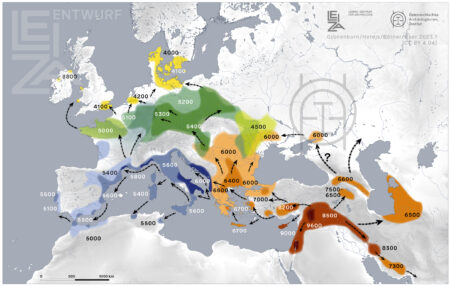- Genetic diversity of the cultivated vanilla in Madagascar. Lots of genetic groups based on SNPs, but not structured in space or environmentally, except maybe by altitude.
- Genetic diversity, population structure, and genome-wide association study for the flowering trait in a diverse panel of 428 moth bean (Vigna aconitifolia) accessions using genotyping by sequencing. NW India is a centre of diversity.
- Chromosome-level genome assembly and population genomic resource to accelerate orphan crop lablab breeding. Two domestication “events,” with the 2-seeded form originating in Ethiopia.
- Reference proteomes of five wheat species as starting point for future design of cultivars with lower allergenic potential. Einkorn is really low in potential allergens.
- Nazareno Strampelli and the first Green Revolution. And all without SNPs, GWAS, genomes or proteomes.
- Developments on Core Collections of Plant Genetic Resources: Do We Know Enough? Do we ever?
- Assessing Genetic Distinctness and Redundancy of Plant Germplasm Conserved Ex Situ Based on Published Genomic SNP Data. Looks like we may know enough for some things after all.
- An (un)common remedy to Indigenous communities’ subsistence: revisiting Traditional Knowledge Commons. As we delve deeper and deeper into the genetic diversity of collections, let’s not forget the associated Indigenous Knowledge.
- Diversity of sambals, traditional Indonesian chili pastes. Case in point? Any allergens though, I wonder?
Nibbles: Alt-proteins, NPGS, Serviceberry, Fungal diseases, Old Irish farm
- The benefits of alt-proteins spelled out in a report from the Center for Strategic and International Studies. I bet they’ll need alt-genebanks.
- The US national genebank system expertly deconstructed in a page.
- Bozakmin, the best of the berries, used to contrast late stage capitalism with Indigenous gift economies. Well worth the long read.
- Comment in Nature about how we are not taking fungal diseases of crops sufficiently seriously.
- There’s a place in Ireland with a 6000 year history of farming. Well maybe that’s rounded up a bit.
Build you own genebank subsets
Genesys has some cool new functionality: the Subsetting Tool. With it, you have the power to create customized subsets based on the climate and soil variables of your choice. You can read more about it in a blogpost, and in more detail in the user guide. I’l probably blog about it here in due course. Any requests?
The latest on the spread of agriculture in Eurasia
Remember the map of the spread of agriculture in Europe that I mashed up with barley genebank accessions a while back? Well, there’s a new version out, according to a tweet from Detlef Gronenborn.
It will eventually make its way here with the previous versions.
Fertilizers redux
Long-time readers may well remember that we have talked about Malawi’s fertilizer subsidy programme a number of times here over the past — what is it now? — 15 years?
Let’s recap.
Controversially, against the advice of its most powerful donors, Malawi’s President Bingu wa Mutharika subsidized inputs through a government-funded voucher scheme known as the Farm Input Subsidy Program (FISP). Millions of small-holder farmers received fertilizer and improved seed at a fraction of the market price… With good rains and a strong response to subsidized fertilizer and improved seeds, national maize production doubled in 2006.
That’s from a recent commentary by Glenn Denning, Professor of Professional Practice at the School of International and Public Affairs, Columbia University. There has been much criticism of the strategy over the intervening years, just look at some of the articles and papers we have linked to over the years, but Prof. Denning seems to have no doubt that in the end it worked, and not just in Malawi.
Critics argued Mutharika struck it lucky with the weather, and that these results could not be sustained… However, despite changes in national leadership and stop-start support from Malawi’s donors, the FISP has continued as a strategy for increasing farm productivity and national food security. The results are impressive. Since 2005, Malawi’s farmers have generated surpluses over national requirements in all but three years—2015, 2016, and 2018… National maize production increased by 79 percent between 2004 and 2019 (comparing averages for 2002-2004 and 2017-2019). This increase was the product of a 62% increase in average yield and 10% increase in harvested area. As a country with limited land resources and a high population density, Malawi’s increase in maize production mirrored the experience of Asia, demonstrating that it was possible to intensify existing cultivated land under rainfed conditions.
So, mission accomplished, right? Ahem, not quite…
Despite these encouraging results from Malawi and sub-Saharan Africa as a whole, it would be premature to declare “mission accomplished.”
Damn. So what else do we need to do, for pity’s sake? I was thinking we had the elusive silver bullet here.
Well, Prof. Glenn Denning does double down on better-maize-seeds-plus-fertilizer, but says it’s time to add a distinctly green twist:
- reduce the footprint of fertilizers through more precise recommendations and deploying more efficient varieties
- restore abandoned land through the strategic use of legumes and trees
- abandon some annual crops for more tree-based systems
- reduce post-harvest losses
- protect natural ecosystems
Fertilizers, plus agrobiodiversity, you could say.
